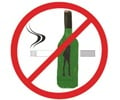A combination of second-hand smoke exposure and alcohol greatly raise the risk of liver disease and is deadlier than the individual exposure risks.
A combination of second-hand smoke exposure and alcohol greatly increase the risk of liver disease and is deadlier than the individual exposure risks, according to researchers at the University of Alabama at Birmingham (UAB).
Shannon Bailey, Ph.D., an associate professor in the UAB Department of Environmental Health Sciences and a co-lead author on the study, said that the findings support that tobacco smoke and alcohol are worse for health as a combination, beyond the individual exposure risks."This new data is a significant finding considering the combined effect of alcohol and cigarette smoke exposures, and the implications for public health," said Bailey.
For the study, the researchers exposed mice to smoky air in a laboratory enclosure and fed a liquid diet containing ethanol, the intoxicating ingredient in alcohol drinks.
It was found that mice exposed to second-hand smoke and who drank ethanol had 110 percent more liver fibrosis proteins than mice who breathed filtered air.
Also, the twice-exposed mice had 65 percent more liver fibrosis proteins than mice that breathed smoky air but did not drink ethanol. Fibrosis is scar-like tissue in the liver that can lead to cirrhosis.
In an earlier study it was found that the combination of second-hand smoke and ethanol increased the biological signs of heart disease in mice.
Advertisement
Other than measuring liver fibrosis proteins in the study mice, the researchers looked at other signs of advancing liver disease like DNA damage, unhealthy cholesterol and oxidative stress.
Advertisement
Source-ANI
THK/S














